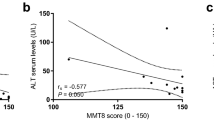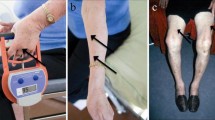Abstract
Sporadic inclusion-body myositis (s-IBM) is the only muscle disease in which accumulation of amyloid-β (Aβ) in abnormal muscle fibers appears to play a key pathogenic role. Increased amyloid-β precursor protein (AβPP) and Aβ accumulation have been reported to be upstream steps in the development of the s-IBM pathologic phenotype, based on cellular and animal models. Aβ is released from AβPP as a 40 or 42 aminoacid peptide. Aβ42 is considered more cytotoxic than Aβ40, and it has a higher propensity to aggregate and form amyloid fibrils. Using highly specific antibodies, we evaluated in s-IBM muscle biopsies intra-muscle fiber accumulation of Aβ40 and Aβ42-immunoreactive aggregates by light- and electron-microscopic immunocytochemistry, and quantified their amounts by ELISA. In s-IBM, 80–90% of the vacuolated muscle fibers and 5–20% of the non-vacuolated muscle fibers contained plaque-like Aβ42-immunoreactive inclusions, while only 69% of those fibers also contained Aβ40 deposits. By immuno-electronmicroscopy, Aβ42 was associated with 6–10 nm amyloid-like fibrils, small electron-dense floccular clumps and larger masses of amorphous material. Aβ40 was present only on small patches of floccular clumps and amorphous material; it was not associated with 6–10 nm amyloid fibrils. By ELISA, in s-IBM muscle biopsies Aβ42 was present in values 8.53-44.7 pg/ml, while Aβ40 was not detectable; normal age-matched control biopsies did not have any detectable Aβ42 or Aβ40. Thus, in s-IBM muscle fibers, Aβ42 is accumulated more than Aβ40. We suggest that Aβ42 oligomers and their cytotoxicity may play an important role in the s-IBM pathogenesis.



Similar content being viewed by others
References
Askanas V, Engel WK, Alvarez RB (1992) Light-and electron microscopic localization of β-amyloid protein in muscle biopsies of patients with inclusion-body myositis. Am J Pathol 141:31–36
Askanas V, Alvarez RB, Engel WK (1993) Beta-amyloid precursor epitopes in muscle fibers of inclusion body myositis. Ann Neurol 34:551–560. doi:10.1002/ana.410340408
Askanas V, Engel WK, Alvarez RB (1993) Enhanced detection of Congo-red positive amyloid deposits in muscle fibers of inclusion-body myositis and brain of Alzheimer’s disease using fluorescence technique. Neurology 43:1265–1267
Askanas V, Engel WK (1998) Does overexpression of AßPP in aging muscle have a pathogenic role and relevance to Alzheimer’s disease? Am J Pathol 153:1673–1677
Askanas V, Engel WK, Yang CC, Alvarez RB, Lee VM, Wisniewski T (1998) Light and electron microscopic immunolocalization of presenilin 1 in abnormal muscle fibers of patients with sporadic inclusion-body myositis and autosomal-recessive inclusion-body myopathy. Am J Pathol 152:889–895
Askanas V, Engel WK (2007) Inclusion-body myositis, a multifactorial muscle disease associated with aging: current concepts of pathogenesis. Curr Opin Rheumatol 19:550–559. doi:10.1097/BOR.0b013e3282efdc7c
Askanas V, Engel WK (2008) Inclusion-body myositis: muscle-fiber molecular pathology and possible pathogenic significance of its similarity to Alzheimer’s and Parkinson’s disease brains. Acta Neuropathol 116:583–595. doi:10.1007/s00401-008-0449-0
Barelli H, Lebeau A, Vizzavona J, Delaere P, Chevallier N, Drouot C et al (1997) Characterization of new polyclonal antibodies specific for 40 and 42 amino acid-long amyloid beta peptides: their use to examine the cell biology of presenilins and the immunohistochemistry of sporadic Alzheimer’s disease and cerebral amyloid angiopathy cases. Mol Med 3:695–707
Bitan G, Kirkitadze MD, Lomakin A, Vollers SS, Benedek GB, Teplow DB (2003) Amyloid beta -protein (Abeta) assembly: Abeta 40 and Abeta 42 oligomerize through distinct pathways. Proc Natl Acad Sci USA 100:330–335. doi:10.1073/pnas.222681699
Y-Ru Chen, Glabe C (2006) Distinct early folding and aggregation properties of Alzheimer amyloid-β peptides Aβ40 and Aβ42. J Biol Chem 281:24414–24422. doi:10.1074/jbc.M602363200
Chromy BA, Nowak RJ, Lambert MP, Viola KL, Chang L, Velasco PT et al (2003) Self-assembly of Abeta (1–42) into globular neurotoxins. Biochemistry 42:12749–12760. doi:10.1021/bi030029q
El-Agnaf OM, Mahil DS, Patel BP, Austen BM (2000) Oligomerization and toxicity of beta-amyloid-42 implicated in Alzheimer’s disease. Biochem Biophys Res Commun 273:1003–1007. doi:10.1006/bbrc.2000.3051
Engel WK, Askanas V (2006) Inclusion-body myositis: clinical, diagnostic, and pathologic aspects. Neurology 66:S20–S29. doi:10.1212/01.wnl.0000192260.33106.bb
Fratta P, Engel WK, McFerrin J, Davies KJA, Lin SW, Askanas V (2005) Proteasome inhibition and aggresome formation in sporadic inclusion-body myositis and in amyloid-beta precursor protein-overexpressing cultured human muscle fibers. Am J Pathol 167:517–526
Glabe C (2001) Intracellular mechanisms of amyloid-accumulation and pathogenesis in Alzheimer’s disease. J Mol Neurosci 17:137–145. doi:10.1385/JMN:17:2:137
Gouras GK, Xu H, Jovanovic JH, Buxbaum JD, Wang R, Greengard P, Relkin NR, Gandy S (1998) Generation and regulation of beta-amyloid peptide variants by neurons. J Neurochem 71:1920–1925
Gouras GK, Tsai J, Naslund J, Vincent B, Edgar M, Checler F et al (2000) Intraneuronal Abeta42 accumulation in human brain. Am J Pathol 156:15–20
Greenfield JP, Tsai J, Gouras GK, Hai B, Thinakaran G, Checler F et al (1999) Endoplasmic reticulum and trans-Golgi network generate distinct populations of Alzheimer beta-amyloid peptides. Proc Natl Acad Sci USA 96:742–747. doi:10.1073/pnas.96.2.742
Kitazawa M, Green KN, Caccamo A, LaFerla FM (2006) Genetically augmenting Abeta42 levels in skeletal muscle exacerbates inclusion body myositis-like pathology and motor deficits in transgenic mice. Am J Pathol 168:1986–1997. doi:10.2353/ajpath.2006.051232
Marlow L, Cain M, Pappolla MA, Sambamurti K (2003) Beta-secretase processing of the Alzheimer’s amyloid protein precursor (APP). J Mol Neurosci 20:233–239. doi:10.1385/JMN:20:3:233
Masuda Y, Uemura S, Ohashi R, Nakanishi A, Takegoshi K, Shimizu T, Shirasawa T, Irie K (2008) Identification of physiological and toxic conformations in Abeta42 aggregates. ChemBioChem 10:287–295. doi:10.1002/cbic.200800411
Mirabella M, Alvarez RB, Bilak M, Engel WK, Askanas V (1996) Difference in expression of phosphorylated tau epitopes between sporadic inclusion-body myositis and hereditary inclusion-body myopathies. J Neuropathol Exp Neurol 55:774–786. doi:10.1097/00005072-199607000-00003
Needham M, Mastaglia FL (2007) Inclusion body myositis: current pathogenetic concepts and diagnostic and therapeutic approaches. Lancet Neurol 6:620–631. doi:10.1016/S1474-4422(07)70171-0
Nogalska A, Engel WK, McFerrin J, Kokame K, Komano H, Askanas V (2006) Homocysteine-induced endoplasmic reticulum protein (Herp) is up-regulated in sporadic inclusion-body myositis and in endoplasmic reticulum stress-induced cultured human muscle fibers. J Neurochem 96:1491–1499. doi:10.1111/j.1471-4159.2006.03668.x
Oddo S, Caccamo A, Tseng B, Vasilevko V, Cribs DH et al (2008) Blocking Abeat42 accumumulation delays the onset and progression of tau pathology via the C terminus of heat shock protein70-interacting protein: a mechanistic link between Abeta and tau pathology. J Neurosci 28:12163–12175. doi:10.1523/JNEUROSCI.2464-08.2008
Sarkozi E, Askanas V, Johnson SA, Engel WK, Alvarez RB (1993) Beta-Amyloid precursor protein mRNA is increased in inclusion-body myositis muscle. Neuroreport 4:815–818. doi:10.1097/00001756-199306000-00055
Scheuner D, Eckman C, Jensen M, Song X, Citron M, Suzuki N et al (1996) Secreted amyloid beta-protein similar to that in the senile plaques of Alzheimer’s disease is increased in vivo by the presenilin 1 and 2 and APP mutations linked to familial Alzheimer’s disease. Nat Med 2:864–870. doi:10.1038/nm0896-864
Serpell LC (2000) Alzheimer’s amyloid fibrils: structure and assembly. Biochim Biophys Acta 1502:16–30
Suh YH, Checler F (2002) Amyloid precursor protein, presenilins, and alpha-synuclein: molecular pathogenesis and pharmacological applications in Alzheimer’s disease. Pharm Rev 54:469–525. doi:10.1124/pr.54.3.469
Vattemi G, Engel WK, McFerrin J, Buxbaum JD, Pastorino L, Askanas V (2001) Presence of BACE1 and BACE2 in muscle fibres of patients with sporadic inclusion-body myositis. Lancet 358:1962–1964. doi:10.1016/S0140-6736(01)06969-0
Vattemi G, Engel WK, McFerrin J, Pastorino L, Buxbaum JD, Askanas V (2003) BACE1 and BACE2 in pathologic and normal human muscle. Exp Neurol 179:150–158. doi:10.1016/S0014-4886(02)00025-0
Vattemi G, Kefi M, Engel WK, Askanas V (2003) Nicastrin, a novel protein participating in amyloid-b production, is overexpressed in sporadic inclusion-body myositis muscle. Neurology 60:A315
Vattemi G, Engel WK, McFerrin J, Askanas V (2004) Endoplasmic reticulum stress and unfolded protein response in inclusion-body myositis muscle. Am J Pathol 164:1–7
Vetrivel KS, Thinakaran G (2006) Amyloidogenic processing of beta-amyloid precursor protein in intracellular compartments. Neurology 66:S69–S73. doi:10.1212/01.wnl.0000192107.17175.39
Wojcik S, Engel WK, McFerrin J, Paciello O, Askanas V (2006) AbetaPP-overexpression and proteasome inhibition increase αB-crystallin in cultured human muscle: relevance to inclusion-body myositis. Neuromuscul Disord 16:839–844. doi:10.1016/j.nmd.2006.08.009
Yanker BA, Lu T (2008) Amyloid β-protein toxicity and the pathogenesis of Alzheimer’s disease. J Biol Chem doi:10.1074/jbc.R800018200
Acknowledgments
Dr. Vattemi’s current address is Clinica Neurologica, Policlinico G.B. Rossi, Via Delle Menegone 10, I-37134 Verona, Italy. Dr. Nogalska is on leave from Department of Biochemistry, Medical University of Gdansk, Gdansk, Poland. Maggie Baburyan provided excellent technical assistance in electronmicroscopy.
Author information
Authors and Affiliations
Corresponding author
Additional information
Supported by grants from the National Institutes of Health (Merit Award AG16768), the Muscular Dystrophy Association and The Myositis Association (to VA). FC is supported by the Fondation pour la Recherche Médicale.
Rights and permissions
About this article
Cite this article
Vattemi, G., Nogalska, A., King Engel, W. et al. Amyloid-β42 is preferentially accumulated in muscle fibers of patients with sporadic inclusion-body myositis. Acta Neuropathol 117, 569–574 (2009). https://doi.org/10.1007/s00401-009-0511-6
Received:
Revised:
Accepted:
Published:
Issue Date:
DOI: https://doi.org/10.1007/s00401-009-0511-6




